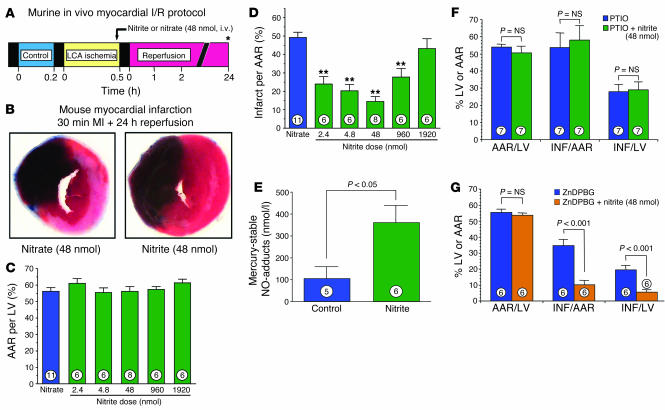Figure 2.
Nitrite therapy in myocardial I/R injury. (A) Experimental protocol for myocardial I/R studies in mice. Asterisk indicates in vivo AAR as shown by Evans blue injection, with infarct size 1.0% of 2,3,5-triphenyltetrazolium chloride (TTC). (B) Representative photomicrographs of murine hearts after 30 minutes of myocardial ischemia (MI) and 24 hours of reperfusion. Areas of the myocardium that appear blue (i.e., Evans blue dye) represent the areas of myocardium not at risk for infarction. In contrast, the areas of myocardium that stain red (i.e., TTC-positive) represent viable myocardium that was at risk for infarction. Myocardium that appears pale (i.e., TTC-negative) indicates areas of myocardium at risk that are necrotic (i.e., infarcted). Nitrite treatment significantly reduced myocardial infarction after 30 minutes of myocardial ischemia and 24 hours of reperfusion. (C) Myocardial AAR per LV for mouse hearts receiving nitrate (48 nmol) or doses of nitrite ranging from 2.4 to 1,920 nmol. The myocardial AAR per LV was similar for all of the study groups (P = NS between groups). (D) Myocardial infarct size per AAR for mouse hearts receiving nitrate (48 nmol) or doses of nitrite ranging from 2.4 to 1,920 nmol. Nitrite therapy (2.4–960 nmol) significantly reduced myocardial infarct size compared with nitrate therapy (**P < 0.001). (E) Blood levels of iron-nitrosylated hemoglobin after intraventricular injection of 48 nmol nitrite. (F) Myocardial AAR per LV and infarct size (INF) per AAR and per LV in mice treated with the NO scavenger PTIO prior to nitrite therapy (48 nmol). Nitrite-mediated cardioprotection was not observed in the presence of PTIO (P = NS, PTIO versus PTIO + nitrite). (G) Myocardial AAR per LV and INF per AAR and per LV in mice treated with the HO-1 inhibitor ZnDPGG prior to nitrite therapy (48 nmol). Treatment with ZnDPGG did not attenuate the protective effects of nitrite therapy. Numbers inside bars indicate the number of animals that were investigated in each group.

